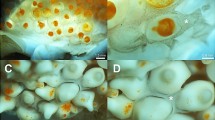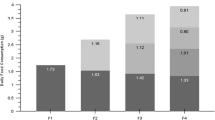Abstract
The maternal–embryo relationship was determined for the piked spurdog (Squalus megalops). In addition, the increase in offspring size with maternal size was studied and the embryonic development was described. Wet weight of in utero eggs and offspring size was correlated with maternal size; larger females produced larger embryos which would have higher survival rate and reproductive value. All embryos present in a female were at a similar stage of development. The external yolk sac is reabsorbed late in gestation, suggesting that embryos are mostly nourished by yolk sac reserves. Embryo size-at-birth varied considerably (180–244 mm total length) as a result of the significant variability in ova size at ovulation. The amounts of water, organic and inorganic matter of embryos at different stages of development were measured to determine possible maternal contributions during embryonic development. Total wet weight from smallest and largest in utero eggs to smallest and largest term embryos changed by +46 and +58%, respectively. This pattern was due to a change in water content by +137 and +154%, and inorganic matter by +100 and +156%. Organic matter of smallest and largest in utero eggs changed by −23 and −17%, respectively. The uterus of pregnant females became specialised for water and mineral transport, not nutrient provision. These results indicate that S. megalops is a strict yolk-sac viviparous species with no maternal contribution of organic matter during development.







Similar content being viewed by others
References
Amoroso EC (1960) Viviparity in fishes. Symp Zool Soc Lond 1:153–181
Bass AJ, D’Aubrey JD, Kistnasamy N (1976) Sharks of the east coast of southern Africa. VI. The families Oxynotidae, Squalidae, Dalatiidae and Echinorhinidae. Oceanographic Research Institute investigational report 45
Begon M, Harper JL, Townsend CR (1990) Ecology: individuals, populations and communities. Blackwell Scientific, Boston
Berridge MJ, Oschman JL (1972) Transporting epithelia. Academic, New York
Braccini JM, Gillanders BM, Walker TI (2006) Determining reproductive parameters for population assessments of chondrichthyan species with asynchronous ovulation and parturition: piked spurdog (Squalus megalops) as a case study. Mar Freshw Res 57:105–119
Branstetter S (1990) Early life-history implications of selected carcharhinoid and lamnoid sharks of the northwest Atlantic. In: Pratt HL Jr, Gruber SH, Taniuchi T (eds) Elasmobranchs as living resources: advances in biology, ecology, systematics, and the status of the fisheries. NOAA technical report NMFS 90, Seattle, pp 17–28
Bulman C, Althaus F, He X, Bax NJ, Williams A (2001) Diets and trophic guilds of demersal fishes of the south-eastern Australian shelf. Mar Freshw Res 52:537–548
Capapé C, Quignard JP (1980) Recherches sur la biologie de Squalus blainvillei (Risso, 1826) (Pisces, Squalidae) des côtes tunisiennes. Relations taille–poids du corps, du foie et des gonades. Coefficients de condition. Rapports hépato et gonosomatique. Croissance embryonnaire. Archs Inst Pasteur Tunis 57:385–408
Capapé C, Seck AA, Diatta Y (2000) Reproductive biology of the common torpedo, Torpedo torpedo (Linnaeus, 1758) (Pisces, Torpedinidae) from the coast of Senegal (eastern tropical Atlantic). Miscel Zool 23:9–21
Chen C, Taniuchi T, Nose Y (1981) Some aspects of reproduction in the pointed-snout dogfish Squalus japonicus taken off Nagasaki and Choshi. Bull Japan Soc Sci Fish 47:1157–1164
Delhaye E, Lechenault H, Wrisez F, Leray C, Haye B, Mellinger J (1992) Localisation, composition et utilisation del lipides vitellins chez Scyliorhinus canicula (L). Bull Soc Zool Fr 117:149–156
Ford E (1921) A contribution to our knowledge of the life histories of the dogfishes landed at Plymouth. J Mar Biol Assoc UK 12:468–505
Francis MP, Stevens JD (2000) Reproduction, embryonic development, and growth of the porbeagle shark, Lamna nasus, in the southwest Pacific Ocean. Fish Bull 98:41–63
Graham KJ (2005) Distribution, population structure and biological aspects of Squalus spp. (Chondrichthyes: Squaliformes) from New South Wales and adjacent Australian waters. Mar Freshw Res 56:405–416
Graham KJ, Andrew NL, Hodgson KE (2001) Changes in relative abundance of sharks and rays on Australian South East Fishery trawl grounds after twenty years of fishing. Mar Freshw Res 52:549–561
Guallart J, Vicent JJ (2001) Changes in composition during embryo development of the gulper shark, Centrophorus granulosus (Elasmobranchii, Centrophoridae): an assessment of maternal–embryonic nutritional relationships. Environ Biol Fishes 61:135–150
Hamlett WC (1993) Ontogeny of the umbilical cord and placenta in the Atlantic sharpnose shark, Rhizoprionodon terraenovae. Environ Biol Fishes 38:253–267
Hamlett WC, Kormanik G, Storrie M, Stevens B, Walker TI (2005) Chondrichthyan parity, lecithotrophy and matrotrophy. In: Hamlett WC (ed) Reproductive biology and phylogeny of Chondrichthyes: sharks, rays and chimaeras. Science Publishers, Enfield, pp 395–434
Hanchet S (1988) Reproductive biology of Squalus acanthias from the east coast, South Island, New Zealand. NZ J Mar Freshw Res 22:537–549
Hisaw FL, Albert A (1947) Observations on the reproduction of the spiny dogfish, Squalus acanthias. Biol Bull 92:187–199
Jollie WP, Jollie LG (1967) Electron microscopic observations on accommodations to pregnancy in the uterus of the spiny dogfish, Squalus acanthias. J Utrastruct Res 20:161–178
Jones BC, Geen GH (1977) Reproduction and embryonic development of spiny dogfish (Squalus acanthias) in the Strait of Georgia, British Columbia. J Fish Res Board Can 34:1286–1292
Ketchen KS (1972) Size at maturity, fecundity, and embryonic growth of the spiny dogfish (Squalus acanthias) in British Columbia waters. J Fish Res Board Can 29:1717–1723
Mellinger J, Wrisez F, Alluchon-Gerard MJ (1986) Developmental biology of an oviparous shark, Scyliorhinus canicula. In: Uyeno T, Arai R, Taniuchi T, Matsuura K (eds) Indo-Pacific fish biology. Proceedings of the second international conference on Indo-Pacific fishes. Ichthyological Society of Japan, Tokyo, pp 310–332
Musick JA, Ellis JK (2005) Reproductive evolution of Chondrichthyans. In: Hamlett WC (ed) Reproductive biology and phylogeny of Chondrichthyes: sharks, rays and chimaeras. Science Publishers, Enfield, pp 45–71
Ranzi S (1932) Le basi fisio-morfologiche dello sviluppo embrionale dei Selaci. Parti I. Pubbl Stz Zool Napoli 13:209–290
Ranzi S (1934) Le basi fisio-morfologiche dello sviluppo embrionale dei Selaci. Parti II et III. Pubbl Stz Zool Napoli 13:331–437
Seck AA, Diatta Y, Diop M, Guélorget O, Reynaud C, Capapé C (2004) Observations on the reproductive biology of the blackchin guitarfish, Rhinobatos cemiculus E. Geoffroy Saint-Hilaire, 1817 (Chondrichthyes, Rhinobatidae) from the coast of Senegal (eastern tropical Atlantic). Sci Gerud 27:19–30
Veríssimo A, Gordo L, Figueiredo I (2003) Reproductive biology and embryonic development of Centroscymnus coelolepis in Portuguese mainland waters. ICES J Mar Sci 60:1335–1341
Walker TI, Hudson RJ, Gason AS (2005) Catch evaluation of target, by-product and by-catch species taken by gillnets and longlines in the shark fishery of south-eastern Australia. J Northwest Atl Fish Sci 35:505–530
Watson G, Smale MJ (1998) Reproductive biology of shortnose spiny dogfish, Squalus megalops, from the Agulhas Bank, South Africa. Mar Freshw Res 49:695–703
Wourms JP (1977) Reproduction and development in chondrichthyan fishes. Am Zool 17:379–410
Wourms JP, Grove BD, Lombardi J (1988) The maternal–embryonic relationship in viviparous fishes. In: Hoar WS, Randall DJ (eds) Fish physiology, vol 11B. Academic, San Diego, pp 1–134
Yano K (1993) Reproductive biology of the slender smoothhound Gollum attenuatus, collected from New Zealand waters. Environ Biol Fishes 38:59–71
Yano K (1995) Reproductive biology of the black dogfish, Centroscyllium fabricii, collected from waters off western Greenland. J Mar Biol Assoc UK 75:285–310
Acknowledgments
We are grateful to Peter Risley, Glenn Richardson and the crew of the fishing vessel ‘Nungurner’ for help in sample collection, to Javier Guallart for help in data analysis and discussion. This research was supported by an International Postgraduate Research Scholarship and a University of Adelaide Postgraduate Research Scholarship to JMB and an Australian Fisheries Research and Development Corporation grant (FRDC 2002/033) to TIW. BMG was supported by an Australian Research Council QEII Research Fellowship. Funding for the field and laboratory components was provided by Sea World Research and Rescue Foundation, Royal Zoological Society of New South Wales, Nature Foundation SA and Royal Zoological Society of South Australia. All experiments carried out in this study comply with the laws of Australia.
Author information
Authors and Affiliations
Corresponding author
Additional information
Communicated by M.S. Johnson, Crawley
Rights and permissions
About this article
Cite this article
Braccini, J.M., Hamlett, W.C., Gillanders, B.M. et al. Embryo development and maternal–embryo nutritional relationships of piked spurdog (Squalus megalops). Mar Biol 150, 727–737 (2007). https://doi.org/10.1007/s00227-006-0393-2
Received:
Accepted:
Published:
Issue Date:
DOI: https://doi.org/10.1007/s00227-006-0393-2




